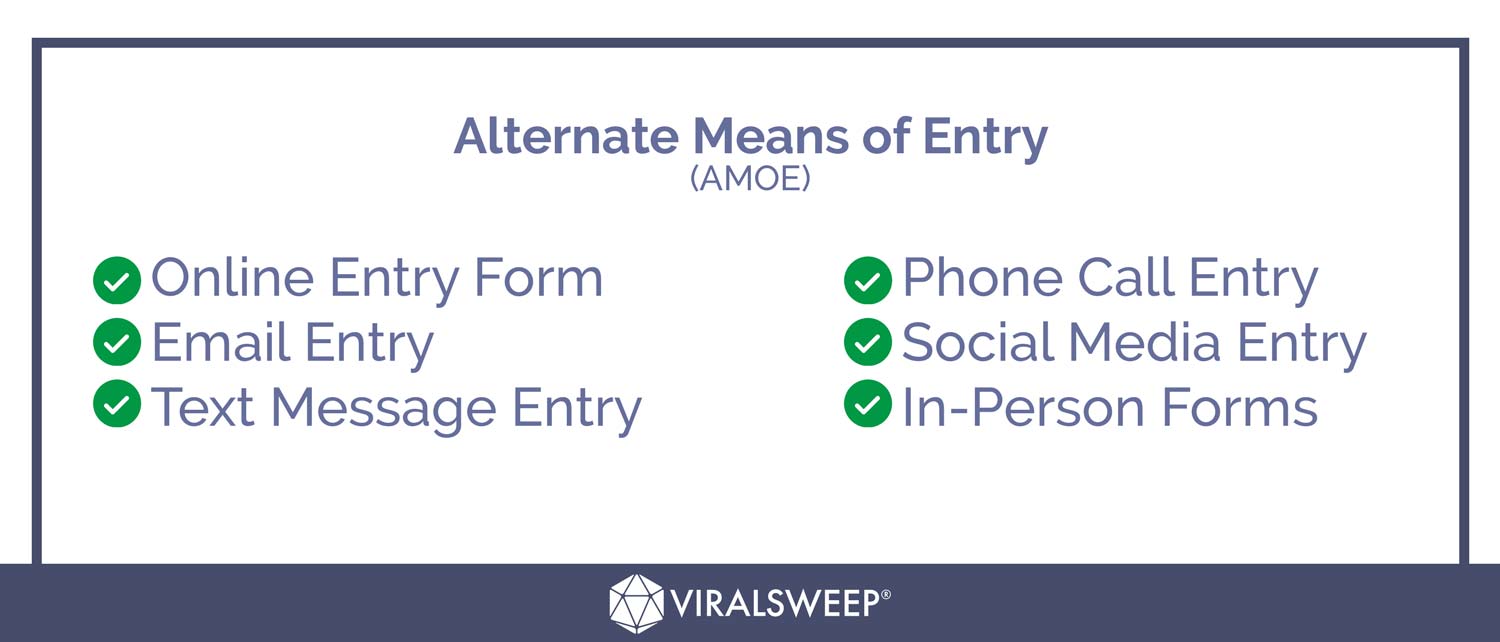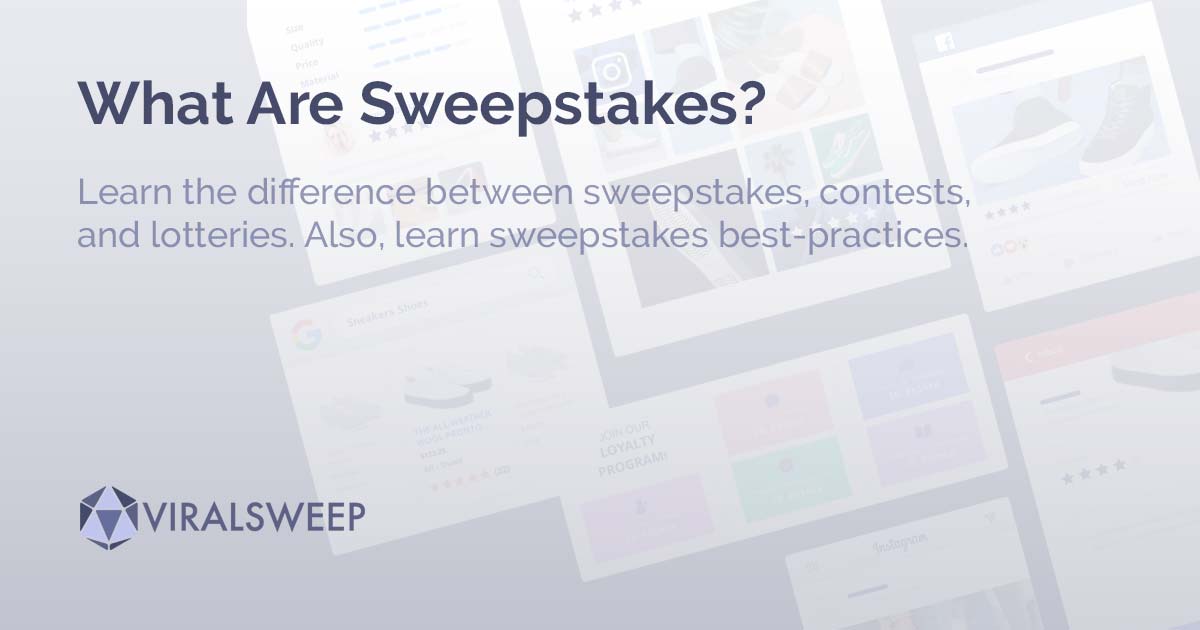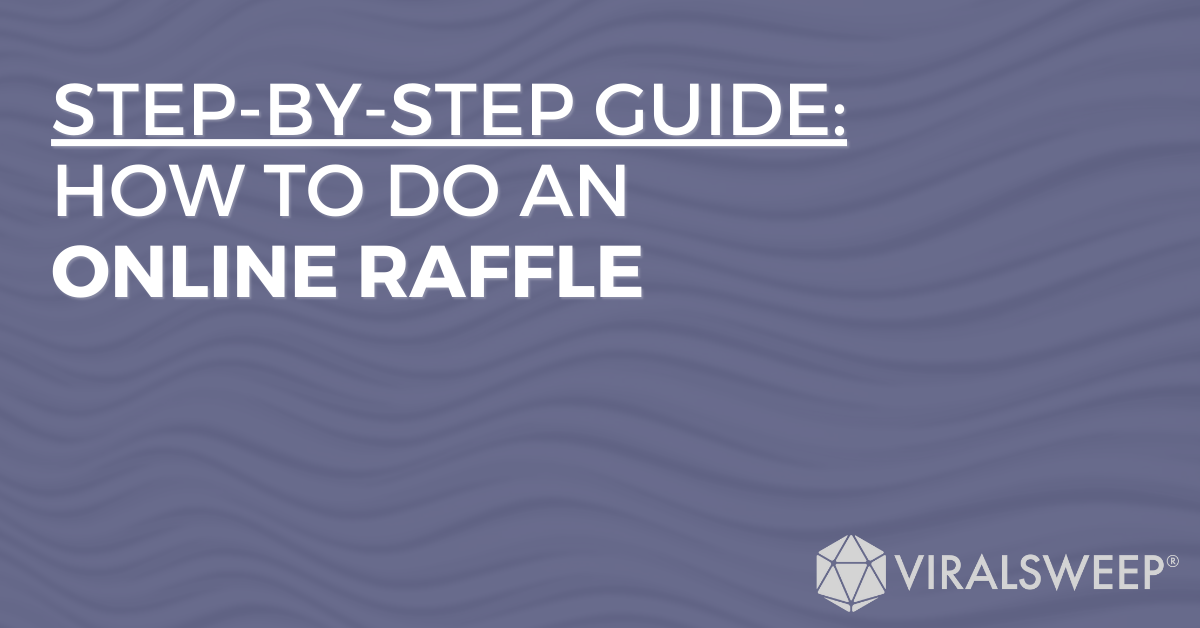We have all heard of sweepstakes but what exactly makes something an official sweepstakes? All your questions answered here!
Difference Between Sweepstakes vs. Contest vs. Lotteries
Most of the time when people say they want to run a contest, they usually do not realize that what they think of as a contest is actually considered a sweepstakes.
Though their terms are frequently used interchangeably, they are two different types of marketing promotions and have distinct differences.
For more detailed information, read ViralSweep’s article on this or check out the video below.
Sweepstakes and contests have three elements that differentiate them: prize, chance, and consideration. See the difference in the following information:
Prize: Anything of value, like goods and services with a monetary value.
Chance: A drawing (sometimes called a raffle) where the participant has no control over the outcome. Usually, this is a random drawing where luck is the deciding factor.
Consideration: A participant is required to make a purchase, pay an entry fee, or expend significant effort to participate.
In a sweepstakes, only prize and chance are involved.
In a contest, only prize and consideration are involved.
In a lottery, prize, chance, and consideration are involved.


What’s a Contest?
A contest is when you give away something, and the winner has to either pay an entry fee or expend significant effort (or meet certain criteria) to participate, and the winner is chosen by judging or voting. These are sometimes referred to as a “game of skill” or skill contests.
Contest Example: Entrants submit a photo, and the photo that gets the most votes wins. Contests are also a widely used marketing strategy; however, they are not always as effective as sweepstakes because of the effort and skill that is required of the participant.
What’s a Sweepstakes?
When it comes to a sweepstakes, you give something away, and the winner is picked at random.
Sweepstakes Example: entrants submit their email addresses to win a $100 gift card, and the winner is picked randomly.
What’s a Lottery?
A lottery is a form of gambling that involves the drawing of numbers at random for a prize. Lotteries come in many formats. They also use paper lottery tickets to administer the event.
Lottery Example: the prize can be a fixed amount of cash (cash prize) or goods. In this format, there is risk to the organizer if insufficient tickets are sold. More commonly, the prize fund will be a fixed percentage of the receipts.
What Are the Differences Between Sweepstakes and Gambling?
A sweepstakes is a type of contest where a prize or prizes may be awarded to a winner or winners or a race on which money is bet and divided among the winners. Contest winners are picked at random.
Sweepstakes are contests where you do not need to spend anything from your pocket to enter or to win.
In addition, legitimate sweepstakes have laws and have strict guidelines such as, “No purchase necessary to enter or win” and “A purchase will not increase your chances of winning”.
The winner of a sweepstakes is chosen by luck and not by skill. Sweepstakes are what some consider a “game of chance.”
In gambling, a person has to pay actual money to participate in contests, to play games, and so on.
And with gambling, the outcome is much more uncertain, unlike a sweepstakes where you know from the beginning how much you could win and when. These are the main ways to differentiate them.
Sweepstakes Laws and Regulations to Consider
You need to consider applicable state laws, federal laws and regulations before running a sweepstakes, and there are multiple agencies, including the FTC (U.S. Federal Trade Commission), USPS (U.S. Postal Service), FCC (Federal Communications Commission), and several state agencies that regulate sweepstakes and giveaways.
[Find sweepstakes laws for every US State here]
Others to consider are the Better Business Bureau guidelines. A lot of these items should be discoverable on the agency website. We are primarily focusing on the United States.
No Purchase Necessary Laws
Fortunately, most of those regulations are found in a set of laws called “No Purchase Necessary” laws.
No Purchase Necessary laws state that you cannot ask entrants to make a purchase or provide some other form of consideration if you are picking a winner at random.
In many states, No Purchase Necessary laws do not apply to contests. Nebraska, Colorado, Maryland, Vermont, and North Dakota are the only exceptions.
Alternate Means of Entry
Of course, you can encourage players to purchase your product while running a sweepstakes by providing a primary means of entry on your product involving a purchase, along with an alternate means that requires no purchase.
Examples of an alternate means of entry (AMOE) could be:
- An online entry form
- An email entry
- A text message or phone entry
- Via social media platforms like Facebook, Instagram, or Twitter
- In-person entry at stores, offices, or events


Additional Regulations
On top of No Purchase Necessary laws and AMOE requirements, a few additional regulations apply to sweepstakes.
With every sweepstakes, the promotion host must:
- Announce the opening and closing dates of the contest
- Disclose the process for choosing and notifying winners
- State when you will award the prizes (especially the grand prize)
We created a detailed post on Sweepstakes Official Rules and another on a sweepstakes legal checklist.
Why You Should Run a Sweepstakes? (The Benefits)
Sweepstakes are ideal for many companies’ marketing strategies. And they are different from other marketing strategies because they create an event, which draws different energy to your brand.
They can help to:
- Create brand awareness
- Collect customer data
- Increase product and service sales
On top of that, they are easy to run!
Increase Brand Awareness
Sweepstakes with valuable or exciting prizes can generate a massive uptake in favorable brand awareness. People do not always respond well to brands that are constantly making claims of greatness.
A sweepstakes is different because you are offering a chance to win something valuable. That gets people’s attention without making them annoyed with your brand for over-advertising.
1. Word of Mouth Marketing
Word-of-mouth marketing (or WOM marketing) is when a consumer’s interest in a company’s product or service is reflected in their daily dialogues.
It is free advertising triggered by customer experiences—and usually, something that goes beyond what they expected.
Word-of-mouth marketing can be encouraged through sweepstakes specifically set up by companies or by having opportunities to encourage consumer-to-consumer and consumer-to-marketer communications.
With ViralSweep, we incorporate word-of-mouth marketing by allowing entrants to earn additional entries with specific social actions they can take such as sharing a post, visiting pages, or referring friends.
Also referred to as “word-of-mouth advertising,” WOM marketing includes buzz, viral, blog, emotional, and social media marketing.
2. Get a Viral Lift from User’s Sharing
A “lift “uses a unique referral system combined with social traffic and email to help users generate more traffic and sales. The most usual format companies use to get viral lifts are contests and sweepstakes.
Capture Valuable Customer Data
Running a sweepstakes also means you will be able to collect customer data that can inform you about your target audience.
1. Build Your Email List
You have to contact the winner, which means you will need basic information from each entrant such as their name and e-mail address.
You can also ask questions about your customers’ hobbies and interests to help with audience segmentation later down the road.
Being able to send contextually relevant information to each audience segment can dramatically increase your conversion rates.
You cannot require entrants to answer them, but optional questions are okay. And a number of people are willing to volunteer information when you are offering a prize in return.
2. Build Your SMS List
SMS is a powerful channel for business-to-consumer (B2C) interactions. Anyone with a phone has texting capabilities, meaning all 15 billion phones in the world are ready to receive this form of communication. That’s more than the number of active social media users or people with an email address.
Boost Your Sales
If you advertise a product purchase as a primary means of entry, sweepstakes can also directly benefit your bottom line.
Though many people will still use an AMOE, many more will be incentivized to make a purchase. And even those that use an AMOE often become actual customers after they have entered the sweepstakes.
The best part of running a sweepstakes, though, is how simple it is!
It costs very little to run, especially if you get creative with prizes. All you need is an easy-to-use marketing tool like ViralSweep.
That makes running sweepstakes one of the easiest and most effective marketing strategies!
1. Drip Emails
Sending emails to over a period of time to your contest entrants can help you build up brand equity and solidify trust.
This is a great opportunity to send messages to your new contacts offering deals, other products that they would like, or content they may find interesting.
2. Run Retargeting Ads
Target specific groups of people who entered the contest, or even visited the contest page but did not enter. Give them contextually relevant offers based on their interactions with your business.
How To Run a Sweepstakes?
ViralSweep has created an advanced sweepstakes guide to help you through this process.
1. Planning Your Sweepstakes
You may be asking yourself – should I run a sweepstakes?
Sweepstakes can provide amazing results for your business, but they are not a silver bullet for marketing.
A successful campaign requires total commitment and execution—more importantly a willingness to think for yourself rather than copy what someone else has done.
Before getting started, ViralSweep wants you to ask yourself a few questions.
Check Out Our Full Product Tour of ViralSweep
2. Sweepstakes Setup
It is important to limit any barriers to entry. Do not overcomplicate your sweepstakes
Apply the KISS (keep it simple, stupid) method when running a sweepstakes. The fewer barriers you put in front of your users, the better your results will be including more entrants.
If you have a complicated entry process, lengthy entry forms, poor visuals, and misleading rules, you will not see positive results. People really dislike Facebook login and apps that request access to specific information just to enter a sweepstakes.
ViralSweep surveyed multiple audiences ranging from developers, designers, and business owners, to moms, dads, and normal everyday online consumers.
When asked specifically about sweepstakes requiring Facebook login to enter, 67% of respondents said they would either not enter the sweepstakes or would look for an alternative method of entry.
3. Pre-Launch Your Sweepstakes
Having a pre-launch strategy for your sweepstakes is extremely important so that you can quickly get the ball rolling and start seeing some results.
Without a pre-launch strategy in place, you will be left with your wheels spinning in the mud. ViralSweep shares a list of 10 items you should do as part of your sweepstakes pre-launch.
4. Launch Day of Your Sweepstakes
Having a launch day strategy is just as important as having a pre-launch strategy.
If you want your giveaway to really take off and grow some legs, you have to have everything in order so that it brings you maximum exposure.
The launch day strategy is all about executing on the pre-launch strategy that has already been put into place, and then taking it one step further.
5. During the Sweepstakes Promotion
Engaging your new audience is extremely important throughout the duration of the sweepstakes.
While the promotion may bring you a crowd of new people, it is up to you to communicate with them. You want to engage with as many new fans and followers as possible, gaining their attention and trust with your content rather than just your sweepstakes.
During this crucial phase of the sweepstakes – focus on engagement.
6. Wrapping up Your Sweepstakes
By this point, you have grown your audience and helped your brand become more visible.
It is time to choose the winners, fulfill the prizes, and leverage the growth your sweepstakes has provided.
Now that your sweepstakes has ended, it is time to analyze the results and see if the promotion was a success. Compare the results of the sweepstakes to the marketing goals that you set before the promotion went live.
Sweepstakes Return on Investment
Sweepstakes FAQ
What are sweepstakes in marketing?
A sweepstakes is a marketing or consumer sales promotion that involves the offering of prizes to participants, where winners are selected by chance and no consideration is required.
Is a sweepstakes the same as a lottery?
Generally, a sweepstakes (a random drawing for a prize) is not classified as a lottery, because it lacks consideration (i.e., something of value that an entrant is required to give). True “contests” do not qualify as lotteries, because skill replaces chance (e.g., the best golfer, the best slogan).
What qualifies as a sweepstakes?
A Sweepstakes is a campaign in which entrants can win a prize based on chance. No purchase, payment, or other consideration is permitted, and the winner is picked at random.
Is a Sweepstakes the Next Move for You and Your Business?
The world of running a sweepstakes can be intimidating, but we have the keys to running one covered here at ViralSweep.
And our app is an immensely helpful solution. We offer excellent support as you implement this new piece of technology in your Shopify store, blog, or any other type of website.





















